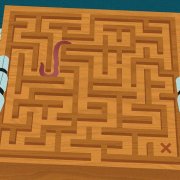by Jonathan Shaw
Could an artificial neural network connected to the brain of a living animal improve its performance on a task, such as the ability to find food? A strength of biologically based intelligence is that it performs well in novel situations by applying principles learned through experience in other contexts. Artificial intelligence (AI), on the other hand, can rapidly process huge quantities of information and thus detect correlations among disparate kinds of data, making connections that a biological neural network might miss.
To test how an artificial and natural system interact, Chenguang Li, a doctoral student in biophysics, linked neurons in the brains of the soil-dwelling nematode worm Caenorhabditis elegans to a reinforcement learning agent designed to handle inputs of recorded data. Reinforcement learning is a form of machine learning in which an algorithm adapts its behavior in response to what it has learned during repeated attempts to achieve a particular outcome. Without human supervision, the agent learns through trial and error how to optimally perform a task.
Li and her advisers—professor of ophthalmology Gabriel Kreiman, an expert in biological and computer vision as well as AI and algorithm design, and Gund professor of neurosciences and of molecular and cellular biology Sharad Ramanathan (see “How to Make a Mammal,” January-February, page 40)—chose a nematode for the experiment because its simple nervous system contains just 302 neurons. Then they trained the AI to assist the animal on specific motor tasks, culminating in a search for food that involved navigating around barriers. The research could one day lead to improved treatments for diseases that affect motor control, such as Parkinson’s.
To allow the AI to modify the worm’s behavior, they used an optogenetic interface, in which neurons in genetically modified worms could be excited or inhibited using blue or green light. They first experimented with a neuron that prompts the worms to turn around, training their agent with video data of worm behavior. Then they gave the agent control of the light, and feedback in the form of video footage from a camera that monitored the worms’ responses—enabling the AI to analyze the effect of the light on the animals’ behavior and movement.
They then repeated the experiment in worms with a gene that encodes a neuron that stimulates the opposite type of behavior (suppressing turning); and then with a neuron whose effect on behavior had not been previously characterized. In all instances, the AI had no prior information about how each neuron behaved yet learned how to integrate its limited ability to intervene in an animal’s observed behavior, successfully guiding it to a target area with food. Control animals—those without an agent or subjected to random light—rarely reached the food.
To understand how the agent was learning, the researchers analyzed what it was “seeing” in the images coming from the camera. They found that it had learned to integrate visual data about the worm’s head and body angles—and what those might signal about its intentions—with the effects of the light...
Read the full article on the Harvard Magazine website using the link below.

